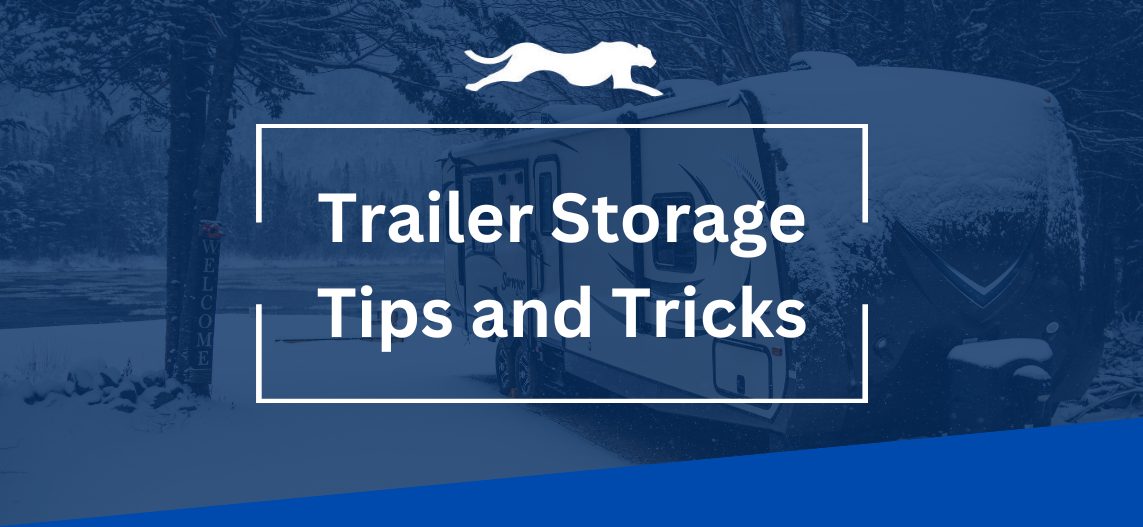When the hauling season winds down, going to store your trailer isn’t just about parking it and walking away. Moisture, UV rays, rodents, flat-spotted tires, and neglected bearings can quietly turn a good trailer into an expensive headache. This guide walks you step-by-step through a thorough off-season storage routine that can be applied to utility, cargo, dump, boat, horse, and equipment trailers alike.
Clean Your Trailer Thoroughly
The first step to store your trailer is cleaning your trailer inside, outside, and underneath. Road film, salt, fertilizer, and organic debris hold moisture and accelerate corrosion. Start with a pre-rinse to knock away grit, then wash with a balanced cleaner and brushes suited to each surface. Pay extra attention to the undercarriage, axles, hubs, brakes, and crossmembers where grime builds up. Wood decks should be scrubbed and sealed, while aluminum surfaces should be inspected for galvanic corrosion. After drying thoroughly, mist exposed steel components with a corrosion inhibitor for added protection.
Perform a Complete Inspection
Once clean, take the time to inspect for damage. Begin at the coupler and safety chains, checking for wear, cracks, or deformation. Work your way along the tongue and frame rails, tapping suspect areas for hidden rust. Suspension systems should be inspected for worn bushings, sagging leaves, or torsion arm misalignment. Axles must be checked for straightness, seals for leaks, and hubs for play or discoloration. Don’t forget to test your brakes—whether electric or hydraulic—and verify that your wiring, lights, and roof seams (if enclosed) are intact. Addressing small issues now prevents costly failures later.
Protect and Maintain Your Tires
Tire care is critical during storage. Inflate each tire to its proper PSI before parking and consider adding a few extra pounds without exceeding the maximum rating. To prevent flat spots, many owners prefer storing their trailer on jack stands, taking pressure off the tires entirely. If this isn’t an option, use rubber wheel chocks and avoid parking directly on soil or asphalt by placing boards beneath the tires. Tire covers provide UV protection and extend the life of the rubber. Always torque lug nuts to specification before storage and again after the first drive of the season.
Grease Bearings and Moving Parts
Greasing your bearings and other moving parts adds another layer of defense. If your trailer has seen heavy use or exposure to water, repack bearings before storage and replace the seals. For greaseable hubs, pump fresh grease slowly while rotating the hub to avoid blowing seals. Lubricate the coupler latch, jack screw, hinges, and door latches to ensure everything remains smooth and rust-free during downtime.
Care for Batteries and Electrical Systems
If your trailer has a battery for a breakaway system or accessories, it should be disconnected or removed. Store the battery in a cool, dry place and keep it on a smart maintainer. Clean the terminals and apply dielectric grease before reinstalling in spring. Similarly, protect your electrical system by inspecting wiring, cleaning the trailer plug, and sealing exposed connections. Applying dielectric grease and covering the plug keeps moisture and corrosion at bay.
Use a Quality Cover and Moisture Control
Covering your trailer helps protect against the elements while you store your trailer, but it’s important to choose wisely. A breathable cover is best, as it prevents UV damage while allowing trapped moisture to escape. Avoid cheap tarps, which trap condensation and scuff paint. Enclosed trailers benefit from cracked vents and moisture absorbers inside, while horse or cargo trailers should be emptied of bedding or feed to deter rodents. Applying silicone protectant to seals ensures doors and ramps stay pliable.
Secure Your Trailer Against Theft
Security is another vital consideration. Even in storage, trailers are attractive targets for theft. Use a hitch lock, wheel lock, or both to deter opportunists, and consider removing a wheel if the trailer will sit outside long term. Parking with the coupler facing a wall or fence adds another layer of protection, and installing a GPS tracker ensures you can locate your trailer if it’s ever moved.
Choose the Right Storage Location
Choosing the right storage location makes a difference as well. A covered garage or barn is ideal, but if outdoor storage is your only option, pick a level area with good drainage. Standing water near the frame or tires accelerates corrosion, so avoid low-lying areas. Parking with a slight nose-down angle helps drain rain and snow from the roof. Pest-proofing by sealing openings and placing deterrents inside helps keep rodents away during the cold months.
Special Trailer Types Require Extra Care
Special trailer types require extra care. Dump trailers should be stored with the bed lowered and cylinders retracted, and their hydraulic systems checked for leaks. Boat trailers must be thoroughly rinsed with fresh water after their final use of the season, with bearings greased immediately afterward. Enclosed trailers benefit from roof resealing and roller lubrication, while horse trailers should be disinfected, dried, and vented to stay fresh.
Perform Monthly Storage Checks
While you store your trailer, It’s also wise to check on your trailer once a month. A five-minute walk-around ensures the cover is secure, tires remain inflated, desiccants aren’t saturated, and no tampering or rodent activity has occurred. These quick checks catch small issues before they snowball.
Get Your Trailer Ready for Spring
When spring arrives, recommissioning your trailer should be straightforward if you followed these steps. Reinstall and charge the battery, test the breakaway switch, set tire pressures, and re-torque the lug nuts. Inspect bearings and brakes, confirm wiring and lighting function, and take a cautious test drive to listen for any issues. This final check ensures your trailer is safe and ready for another season of service.
If your off-season inspection revealed worn hubs, bearings, seals, or axles, don’t wait until spring to order replacements. Blueswift Axles offers the fastest build and shipping lead times in the industry. Proper off-season storage paired with timely parts replacement means less downtime and more confidence on the road when hauling season begins again.
